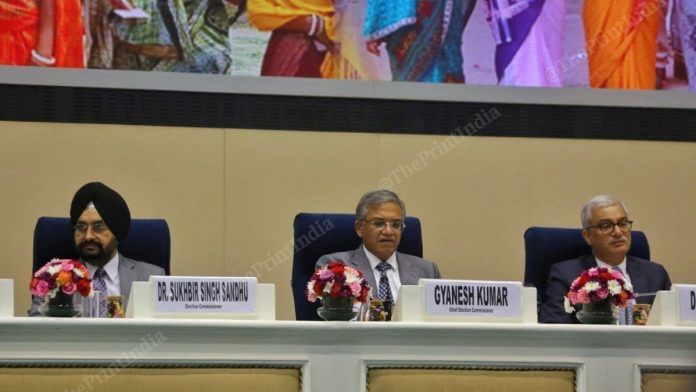New Delhi: The assembly election in Bihar will be held in two phases on 6 and 11
November, the Election Commission of India announced Monday. The counting of votes will be conducted on 14 November.
Addressing a press conference here, Chief Election Commissioner (CEC) Gyanesh Kumar said Bihar now has 7.42 crore voters, including 14 lakh first-time voters.
This comes in the backdrop of a massive political row over the Special Intensive Revision (SIR) of electoral rolls. The Opposition has dubbed the exercise “vote chori”, while the BJP has targeted the Opposition for allowing “infiltrators”, termed as “ghuspetiyas”, to vote.
After the deletion of nearly 50 lakh names in the controversial exercise, there are 7.42 crore electors now, reflecting a decline of roughly six percent from the pre-SIR 7.89 crore.
The National Democratic Alliance (NDA) government, led by Chief Minister Nitish Kumar, is hoping for a comeback with the BJP. The 243-seat Assembly’s term ends on 22 November.
The NDA is currently busy in seat-sharing talks with alliance partners Lok Janshakti Party (Ram Vilas) or LJP, Hindustani Awam Morcha (Secular) or HAM, and Rashtriya Lok Morcha (Upendra Kushwaha), among others.
In the last assembly elections, held in 2020 when COVID-19 restrictions were in place, the NDA secured 117 seats and formed the Bihar government, while the Rashtriya Janata Dal (RJD) trailed with 75 seats.
The upcoming Bihar election will see a new entrant—the Prashant Kishor-led Jan Suraaj Party (JSP). For the party, this will be the first major electoral test. PK has aggressively been campaigning for his party, accusing several BJP and JD(U) leaders of corruption.
This time around, the contest is likely to be triangular, with the NDA, the INDIA bloc, and Prashant Kishor’s JSP looking to form the government.
The NDA currently holds 131 seats: the BJP’s 80, the JD(U)’s 45, the HAM’s four, and the two seats with Independent MLAs. The Opposition has 111 seats: the RJD’s 77, Congress’s 19, the Communist Party of India (Marxist-Leninist)’s 11, the Communist Party of India (Marxist)’s two seats, as well as the Communist Party of India’s two.
The BJP secured a 20 percent vote share, the RJD 23 percent, the Congress 10 percent, the JD(U) 16 percent, and the Lok Janshakti Party (Ram Vilas) six percent in the 2020 election.
For the upcoming assembly elections, the NDA will rely on developmental works and welfare schemes. Just ahead of the announcement of election dates, Prime Minister Narendra Modi launched Mukhyamantri Mahila Rojgar Yojana—a Bihar government initiative under which 7.5 million women will get Rs 10,000 each for starting ventures of their own. The BJP is hopeful that women voters will once again vote for it in large numbers.
The RJD is relying on anti-incumbency, highlighting its leader and former deputy CM Tejashwi Yadav as a beacon of hope. Tejashwi Yadav has undertaken the ‘Bihar Adhikar Yatra’ to mobilise voters, terming the party’s fight as a counter to the high levels of unemployment and inflation, along with atrocities against women, in Bihar.
Poll consultant-turned-politician Prashant Kishor, who has been attempting to position himself as the “third alternative”, has asked Bihar electors to rise above caste politics and choose a “clean” government.
(Edited by Madhurita Goswami)
Also Read: Where does PK get his money from? ‘Earned Rs 241 crore in 3 yrs, donated Rs 99 crore to Jan Suraaj’






